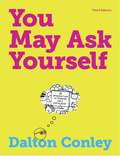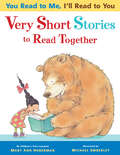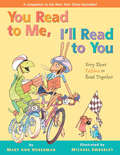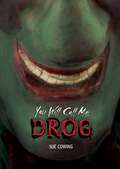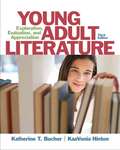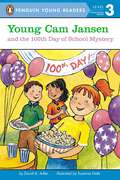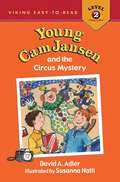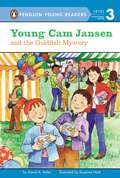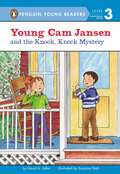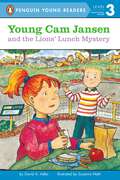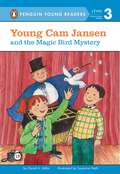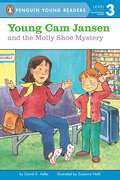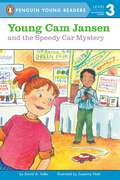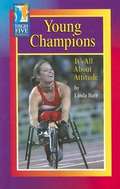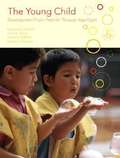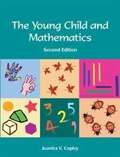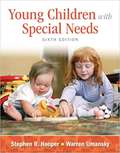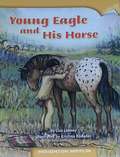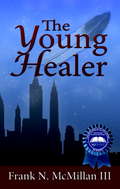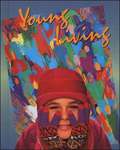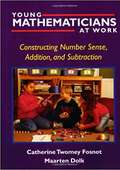- Table View
- List View
You May Ask Yourself: An Introduction To Thinking Like A Sociologist
by Dalton ConleyYou May Ask Yourself gives instructors an alternative to the typical textbook by emphasizing the big ideas of the discipline, and encouraging students to ask meaningful questions. Conley employs a non-textbook strategy of explaining complex concepts through personal examples and storytelling, and integrates coverage of social inequality throughout the text.
You, New Jersey and the World
by John T. CunninghamIntroduces the geography, history, industries, cities, government, and people of "The Garden State."
You Read to Me, I'll Read to You: Very Short Stories to Read Together
by Michael Emberley Mary Ann HobermanHere's a book With something new - You read to me! I'll read to you! We'll read each page To one another - You'll read one side, I the other. But who will read - Now guess this riddle - When the words are In the middle? The answer's easy! Plain as pie! We'll read together, You and I.
You Read to Me, I'll Read to You: Very Short Fables to Read Together
by Michael Emberley Mary Ann HobermanMary Ann Hoberman and Michael Emberley have added Aesop's fables to their bestselling and award-winning series! Rediscover familiar tales and find new favorites in this irresistible fifthYou Read to Me collaboration. These stories of classic characters-from wise ants and kind mice to sly foxes and hungry wolves-are fables as you've never seen them before! With clear, color-coded typography and clever illustrations, this book "in two voices" uses traditional reading teaching techniques-alliteration, rhyme, and repetition-to invite young children to read along with peers or with an adult.
You Will Call Me Drog
by Sue CowingParker is a normal sixth grader—or he was normal before the puppet. It’s just an old hand puppet, sticking out of a garbage can, and even though Parker’s best friend says leave it, Parker brings the puppet home and tries it on. Or maybe it tries him on. “You will call me Drog!” the puppet commands once they’re alone. And now, no matter how hard Parker tries, he can’t get Drog off his hand. Drog is sarcastic, cruel, unpredictable, and loud—everything Parker isn’t. Worse yet, no one believes that Drog—not Parker—is the one saying the outrageous things that get Parker into trouble. Then Drog starts sharpening his snarky wit on the most fragile parts of Parker’s life—like his parents’ divorce. Parker’s shocked, but deep down he agrees with Drog a little. Perhaps Drog is saying things Parker wants to say after all. Maybe the only way to get rid of Drog is to truly listen to him.
Young Adult Literature: Exploration, Evaluation, and Appreciation
by Katherine Bucher KaaVonia HintonPre- and in-service teachers get what they need to connect with adolescent students―and to help them connect with good literature―in this engaging, balanced look at the world of young adult literature. Here readers get foundational knowledge combined with a look at the pathways leading to the literature itself, to begin to open the door to exploring young adult literature. <p><p>Brief enough to give readers the opportunity to read the books themselves, yet comprehensive enough to ensure that teachers truly understand adolescents, their literature, and how to connect the two, this book by Bucher and Hinton provides what’s needed to ensure a rich educational experience for adolescents, while nourishing their love of reading.
Young America, Units 15, 16
by Bailey Phelps Ann Watanabe Marilyn Sprick Wilson OngNIMAC-sourced textbook
Young Cam Jansen and the 100th Day of School Mystery (Young Cam Jansen #15)
by David A. AdlerCam Jansen and her best friend, Eric, are excited about their class's 100th day of school party! To celebrate, they're having snacks that start with the letter P: pretzels, popcorn, pineapple juice, and everybody's favorite, pizza. But when the pizza disappears from the kitchen, it's up to Cam and her photographic memory to "click" and solve this delicious mystery!
Young Cam Jansen and the Circus Mystery (Young Cam Jansen #17)
by David A. AdlerCam and her friend Eric are having a great time at the circus with Aunt Molly - that is, until their box of popcorn goes missing. Did they lose it, or was it stolen? It's up to Cam and her photographic memory to figure it out!
Young Cam Jansen and the Goldfish Mystery (Young Cam Jansen #19)
by David A. AdlerCam, her best friend, Eric, and her aunt Molly win two goldfish at the local fair. When the goldfish go missing, Cam must use her amazing photographic memory to solve the mystery.
Young Cam Jansen and the Knock, Knock Mystery (Young Cam Jansen #20)
by David A. AdlerCam, her best friend Eric, and Eric&’s mom are spending the day with Eric&’s grandparents. But Grandpa and Grandma seem too tired to visit. Every so often, a knock at the door wakes them up. But when they go to answer, no one is there. Is a Knock, Knock Ghost on the loose? It&’s up to Cam to solve the mystery!Garden State Children&’s Book Award 2017 Nominee.
Young Cam Jansen and the Lions' Lunch Mystery (Young Cam Jansen #13)
by David A. AdlerA field trip to the zoo is fun for Cam Jansen and her classmates—until lunchtime. Everyone else’s sandwich is safely delivered, but Danny can’t find his anywhere! Only Cam and her amazing memory can crack this mystery.
Young Cam Jansen and the Magic Bird Mystery (Young Cam Jansen #18)
by David A. AdlerIt's up to Cam to solve this disappearing act! Aunt Molly takes Cam and her friend Eric to see a magic show at Teddy's Toys. During the show, Teddy's bird, Oscar, disappears! Where could he have gone? It's up to Cam to click! and find Oscar before he gets lost in the mall in this Level 3 easy-to-read mystery.
Young Cam Jansen and the Molly Shoe Mystery (Young Cam Jansen #14)
by David A. AdlerAunt Molly is in town. Cam Jansen and her best friend, Eric, are at the airport to greet her. They find Aunt Molly, but her favorite high heels are missing! Did she leave them in Peru, or China, or behind a trash can? Will gumshoe Cam find Aunt Molly?s missing shoes?
Young Cam Jansen and the Speedy Car Mystery (Young Cam Jansen #16)
by David A. AdlerAt her school?s Green Fair, Cam and her friends are learning how to keep the earth green. Everyone is having fun at the exhibits?until a student?s remotecontrolled car goes missing! Was it stolen? It?s up to Cam and her amazing memory to find Speedy.
Young Champions: It's All About Attitude
by Linda BarrIntroduces people who have overcome their handicaps to become extraordinary athletes.
The Young Child: Development from Prebirth through Age Eight (5th Edition)
by Margaret B. Puckett Janet K. Black Donna S. Wittmer Sandra H. PetersenA thorough updating of topics including: standards for early childhood programs, the mandates of IDEA, developmental theories, changing demographics, assessments, child care practices and bullying . For child development courses that cover prebirth through age eight, this widely used text discusses major development theories as they relate to physical, social and emotional, and cognitive domains. The book contains extensive applications for those who teach and work with young children, making it particularly appropriate for early childhood education programs.
The Young Child And Mathematics (Second Edition)
by Juanita V. CopleyReflects recent developments in math education using vignettes from classrooms, activity ideas, and strategies for teaching young children about math processes and concepts. Incorporates standards and guidelines from NCTM and NAEYC.
Young Children with Special Needs
by Warren Umansky Stephen HooperUnderstand typical child development from birth to five and how children with special needs develop differently. Explore six core developmental domains including: gross motor, fine motor and oral motor development, self-care, cognitive development, communication development, and social and emotional development. Read contributions from a variety of experts, each one explaining the latest early intervention strategies within their area of specialty. Learn the process of assessment and intervention and develop universal skills that best support children and their families. Study cases and discuss successful intervention and assessment methods.
Young Eagle and His Horse (Houghton Mifflin Leveled Books #Level 2, Book 7)
by Lisa Lunney Kristina RodanasNIMAC-sourced textbook <p><p> This is Grade 5, Level 2, Book 7 in the Houghton Mifflin Leveled Books series. The book info is as follows: Level: Q / DRA: 40 / Genre: Historical Fiction / Strategy: Visualize / Skill: Understanding Characters / Word Count: 1,267
The Young Healer
by Frank N. Mcmillan IIIIn THE YOUNG HEALER tradition meets contemporary when what starts out as just another day becomes anything but that for young Feather Anderson. Her beloved grandfather, a traditional Lakota healer, pulls her out of class one snowy morning and takes her on an old-fashioned vision quest in the heart of New York City in hopes of finding the perfect Lakota medicine. It becomes the most magical day ever for eleven-year-old Feather Anderson, the day she saves her little brother's life. Feather follows in her grandfather's footsteps of healing as a medicine man and she then earns her newly-given secret Lakota name.
Young Living (Eighth Edition)
by Nanalee ClaytonBuild a foundation of life management skills for your middle school students. Solid content and a vibrant visual appeal make this text a favorite comprehensive overview of all family and consumer sciences areas.
Young Mathematicians At Work: Constructing Number Sense, Addition, And Subtraction
by Catherine Twomey Fosnot Maarten DolkIn our efforts to reform mathematics education, we've learned a tremendous amount about young students' strategies and the ways they construct knowledge, without fully understanding how to support such development over time. The Dutch do. So, funded by the NSF and Exxon, Mathematics in the City was begun, a collaborative inservice project that pooled the best thinking from both countries. In Young Mathematicians at Work, Catherine Fosnot and Maarten Dolk reveal what they learned after several years of intensive study in numerous urban classrooms. The first in a three-volume set, Young Mathematicians at Work focuses on young children between the ages of four and eight as they construct a deep understanding of number and the operations of addition and subtraction. Rather than offer unrelated activities, Fosnot and Dolk provide a concerted, unified description of development, with a focus on big ideas, progressive strategies, and emerging models. Drawing from the work of the Dutch mathematician Hans Freudenthal, they define mathematics as "mathematizing" - the activity of structuring, modeling, and interpreting one's "lived world" mathematically. And they describe teachers who use rich problematic situations to promote inquiry, problem solving, and construction, and children who raise and pursue their own mathematical ideas. In contrast to other books on math reform, Young Mathematicians at Work provides a new look at the teaching of computation. It moves beyond the current debate about algorithms to argue for deep number sense and the development of a repertoire of strategies based on landmark numbers and operations. Sample minilessons on the use of the open number line model are provided to show you how to support the development of efficient computation.
